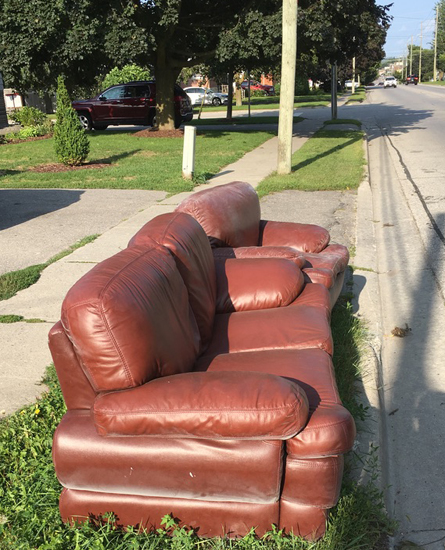
It just looked like a pile of paper from the outside. And I guess because it was paper, it sort of weighed a lot. But the plastic bag I used to haul all that paper to the curb had probably previously hauled groceries from a local store so it could take the weight. And if you looked inside that bag, you’d have seen a number of famous people – John F. Kennedy, Winston Churchill and the Apollo 11 astronauts – all captured on the front pages of old newspapers with headlines such as:
“Kennedy Assassinated,” lamented the Globe and Mail in 1963.
“Churchill Mourned,” announced the Toronto Star in 1965.
“Man Steps On The Moon,” read the Toronto Telegram on July 21 1969. And the newsprint of the Tely, some of you will remember, was coloured pink!
That’s right. All those extraordinary people and all those pivotal moments I had saved for over half a century in that plastic bag. And I had saved them, not for any monetary value, but as mementoes, keepsakes, historical artefacts, if you like, of those tragic and triumphant moments captured in the Toronto newspapers of the day.
Only now, a couple of weeks ago actually, I had decided – after some trepidation – that it was time to let them go. I could just as easily call up those very front pages on the Internet. I could reduce the fire hazard of old, dry paper in my basement. And I could eliminate one more pile of clutter around the house. Those newspapers were going to the curb as recyclable garbage.
At least, that was my intention.
Have you noticed that rather remarkable phenomenon in our town of taking things to the curb as garbage, only to discover they are not? You guessed it. Between the time I hauled all my newspaper front-page archives to the curb in a “We Recycle” blue box on Monday night and the time they were picked up by the garbage truck Tuesday morning, the plastic bag of newspapers had disappeared. I checked. Somebody had gone through the blue box, discovered my gems and decided to claim them. My outgoing newspaper artefacts had survived my sorting decision, and been given a second (or third) life.
The past couple of weeks have been eerily similar. I’ve noticed a lot of odd and unique stuff abandoned on township curbs. In one day alone, I saw two chesterfields sitting at the ends of two different driveways, both within a couple of blocks of each other. I wondered, “Was there a sofa sale going on somewhere? Had all my neighbours decided unanimously to dump their sofas and loveseats this week?”
But they soon disappeared, supposedly the official way, via heavy waste pick-up. But I suspect they were salvaged by someone in need of them. And I thought about my university days, when our four- and five-man flats in downtown Toronto were devoid of furnishings; we regularly went on a residential patrol with somebody’s van looking for such discarded gems as couches and kitchen chairs to fill our empty apartments. Maybe that’s where the concept of curb-omonics came from.
But what still amazes me – year after year – is the value some of us put on things that others of us readily plunk on the roadside never wanting to see again. For example, I think I’ve said, “Good riddance to bad rubbish!” to half a dozen lawn chairs, a couple of rickety tables, the odd broken tool, and my fair share of chopped up dead-fall wood, and left them at the curb, only to notice them disappear overnight.
One of my neighbours threatened to eliminate one of her husband’s over-worn easy chairs that way – claiming she would sneak it to the curb under cover of darkness to have it gone by daybreak. Another discovered a glass and wooden cabinet sitting on a roadside one day; it was shaped for a room corner and so she gave the perfectly sound piece of furniture a new lease on life at her cottage.
But as wasteful as some of our discarding appears, there is a valuable alternative. Some years ago, after both our parents were gone, my sister and I found a man eager to gather the remaining household goods – linens, pots and pans, books, towels, lamps, stools, hangers and utensils – to be packed in a school bus bound for Central and South America, where families less fortunate than we might put them to excellent further use.
This man with the bus was clearly illustrating that “one man’s trash is another man’s treasure.” But I still wondered where my newspaper front pages ended up. Were they simply providing kindling for somebody’s backyard fire pit, or was somebody actually reading Neil Armstrong’s famous July 1969 quotation printed on that pink Tely newsprint for the very first time, “One small step for a man. One giant leap for mankind”?